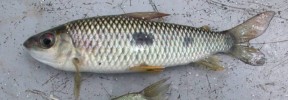Leporinus friderici
Threespot Leporinus
SynonymsTop ↑
Salmo friderici Bloch, 1794
Etymology
Leporinus: from the Latin lepus, meaning ‘hare’, and the suffix -inus, meaning ‘of or pertaining to’, in reference to the enlarged pair of symphyseal teeth possessed by certain members of the genus.
Classification
Order: Characiformes Family: Anostomidae
Distribution
This species was described from Suriname but no specific locality was given.
It’s currently accepted to occur throughout much of the Amazon river system in Brazil, Peru and Bolivia with additional records from coastal drainages of Guyana, Suriname and French Guiana plus the island of Trinidad (Trinidad and Tobago).
Unsurprisingly given this enormous range the fish exhibit certain differences in morphology and, especially, colour pattern depending on locality.
Maximum Standard Length
350 – 400 mm.
Aquarium SizeTop ↑
An aquarium with base dimensions of 240 ∗ 90 cm or equivalent should be the smallest considered.
Maintenance
Décor is relatively unimportant and maintenance simple provided sufficient space is available and oxygenation adequate.
A natural-style arrangement could consist of a sandy substrate with some leaf litter plus large driftwood branches and twisted roots and perhaps some floating vegetation.
Water quality is of the utmost importance and this species should never be introduced to a biologically immature aquarium.
Water Conditions
Temperature: 20 – 28 °C
pH: 5.0 – 8.0
Hardness: 36 – 268 ppm
Diet
Leporinus spp. tend to be predominantly benthic omnivores feeding on algae, invertebrates and organic detritus in nature.
They’re quite unfussy in the aquarium and will accept most things offered, although foods containing high levels of protein are best avoided.
NotesTop ↑
Leporinus is among the more diverse genera in the order Characiformes with around 90 valid species, and a phylogentic study by Sidlauskas and Vari (2008) demonstrated it to represent a polyphyletic lineage.
Four species (H. despaxi, H. megalepis, H. mormyrops and H. pachycheilus) were thus placed into the revalidated genus Hypomasticus which had originally been proposed by Borodin (1929).
The remaining species of Leporinus, except for L. gomesi, formed a clade alongside Abramites, and this grouping was itself placed in a large polytomy alongside the genera Anostomoides, Anostomus, Gnathodolus, Laemolyta, Petulanos, Pseudanos, Rhytiodus, Sartor, Schizodon and Synaptolaemus.
In particular there was an overall lack of a resolution of relationships within Leporinus, and the authors suggested that molecular analysis is likely to be needed to fully resolve the relationships between them.
The family Anostomidae is distributed throughout much of tropical and subtropical South America from northwestern Colombia to central Argentina.
The majority of species are moderately-elongate and somewhat rounded in shape although there are some exceptions, e.g., the relatively deep-bodied Abramites.
Greater diversity is apparent in the range of oral morphology, however, and members exhibit a wide range of adaptations in dentition and jaw structure.
A number of anostomids tend to swim at an oblique ‘head-down’ angle which has given rise to them being referred to by the generalised vernacular term ‘headstanders’.
References
- Reis, R. E., S. O. Kullander and C. J. Ferraris, Jr. (eds.), 2003 - EDIPUCRS, Porto Alegre: i-xi + 1-729
Check list of the freshwater fishes of South and Central America. CLOFFSCA. - Sidlauskas, B. L. and R. P. Vari, 2008 - Zoological Journal of the Linnean Society 154(1): 70-210
Phylogenetic relationships within the South American fish family Anostomidae (Teleostei, Ostariophysi, Characiformes).





